|
|
||||||||||||||||||||||||||||||||||||||||||||||||||||||||||
|
Please sign my Guestbook and leave feedback |
||||||||||||||||||||||||||||||||||||||||||||||||||||||||||
|
Recent Additions |
||||||||||||||||||||||||||||||||||||||||||||||||||||||||||
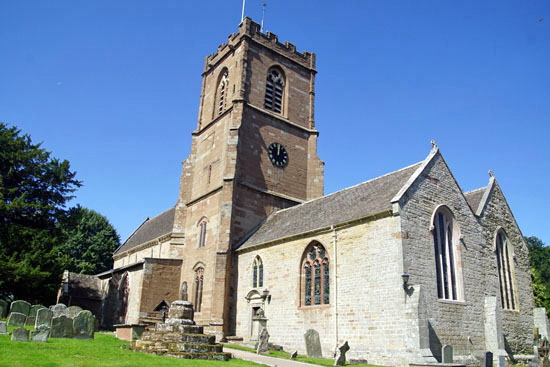 |
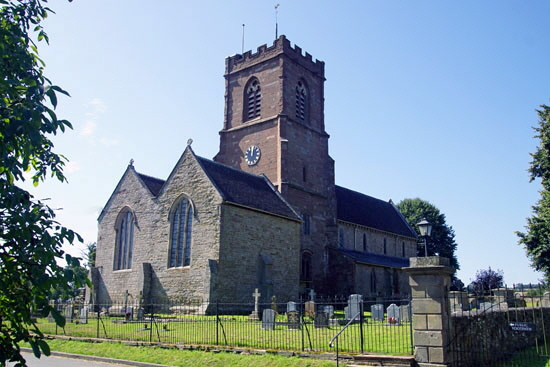 |
||||||||||||||||||||||||||||||||||||||
|
This is a very substantial church for such a rural community. The tower is lofty and looks like some giant has just been planted it here in a space conveniently left for it by an earlier generation. The It is a well proportioned church. Its Early English clerestories are tall, it seems, to accommodate the lancet windows that epitomise the early English style. The two east windows match (although the chapel’s is ever-so-slightly narrower) and note that the roof of the chapel is slightly higher than that of the chancel. |
|||||||||||||||||||||||||||||||||||||||
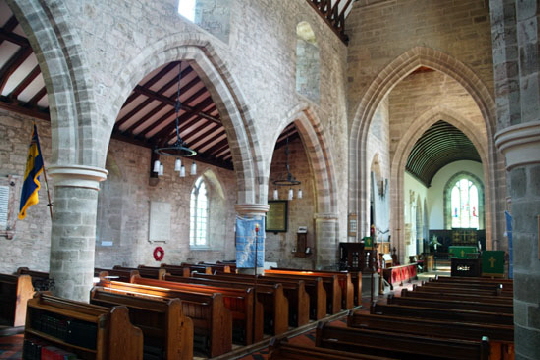 |
|||||||||||||||||||||||||||||||||||||||
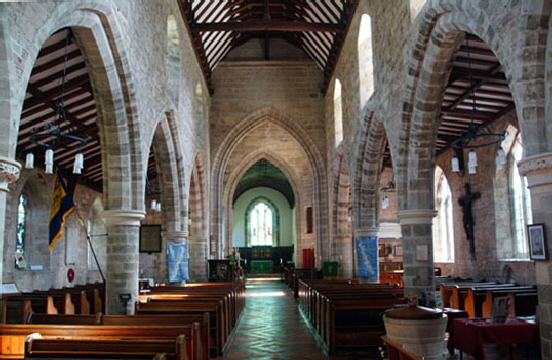 |
|||||||||||||||||||||||||||||||||||||||
|
Left: Looking towards the east. This is a church of noble proportions. Note the tall Early English clerestory. The windows to both aisles are mostly later in a variety of styles. It seems probable that they too were originally lancet windows in which case the tall clerestory would show that was well-planned for light. The arcades have a pleasing symmetry because, of course, they were built at the same time. Right: Looking to the north aisle. The tower arch is tall and elegant. |
|||||||||||||||||||||||||||||||||||||||
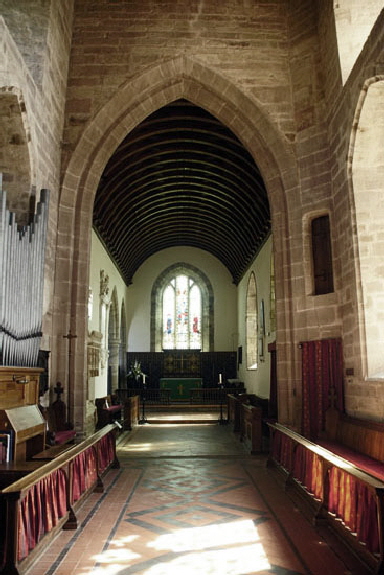 |
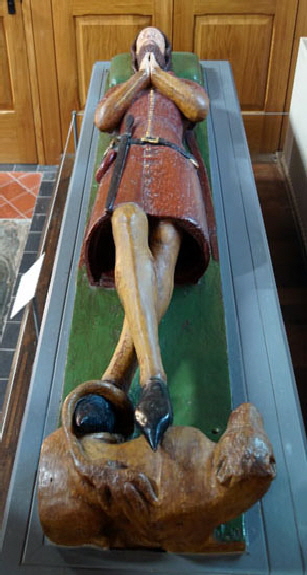 |
||||||||||||||||||||||||||||||||||||||
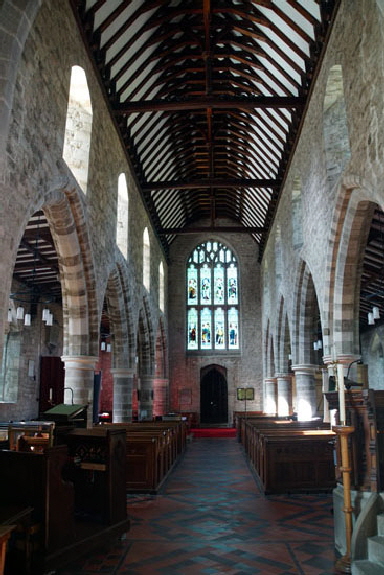 |
|||||||||||||||||||||||||||||||||||||||
|
Left: The church looking towards the east from within the base of the axial tower. I imagine the space has always been used as a choir. Centre:; Looking west. The west window is fifteenth century and appropriately classy for this church. Right: The oaken effigy of Walter de Helyon. This is a true treasure that tells us how the landowning gentry (as opposed to the aristocrats) would have dressed. |
|||||||||||||||||||||||||||||||||||||||
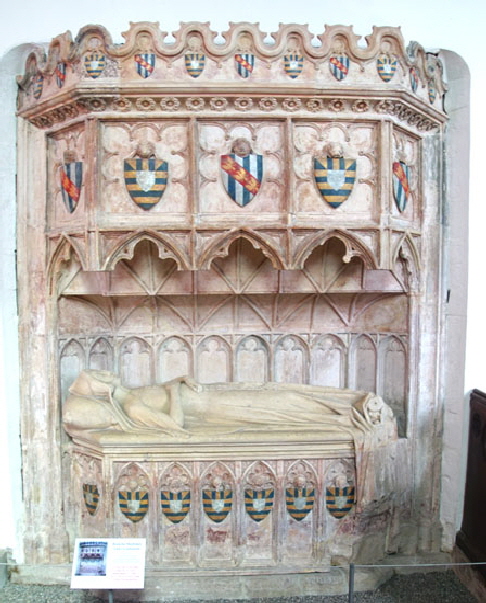 |
|||||||||||||||||||||||||||||||||||||||
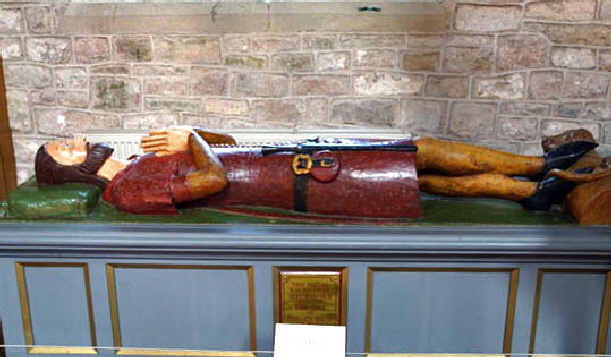 |
|||||||||||||||||||||||||||||||||||||||
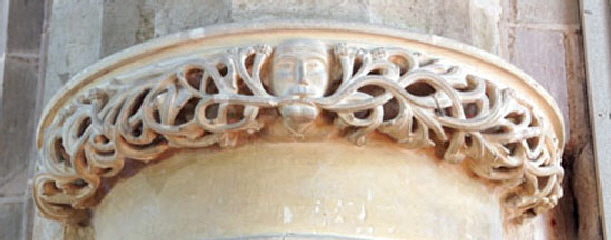 |
|||||||||||||||||||||||||||||||||||||||
|
Upper Left: Another image of Walter de Helyon. The plinth was manufactured for the purpose because the tomb itself is probably at Ashperton Church but the effigy was moved to Much Marcle when Ashperton’s chancel fell down. The colours, by the way, are believed to closely match the originals. Lower Left: This rather wonderful green man with luxuriant foliage is on the capital of easternmost column of the south arcade. Right: The monument to Blanche Mortimer, Lady Grandison. The Mortimers have a society dedicated to them and I am going to quote from their website: “Restorers have unexpectedly discovered the lead-lined coffin of Blanche Mortimer while working on her monument in St Bartholomew's church in Much Marcle, Herefordshire. Blanche was a daughter of Roger Mortimer, 1st Earl of March (d1330) who famously had an affair with Queen Isabella, deposed king Edward II and was executed by their son, king Edward III. Blanche's monument is an outstanding example of 14th century work and her effigy is generally recognised as one of the most beautiful examples of medieval sculpture in the country. It had been assumed that her body would be buried six feet underground so it came as a great surprise to find it in the monument itself. Blanche was married to Peter de Grandison, 2nd Baron Grandison (d.1358) and the Grandison and Mortimer coats of arms are displayed on the monument.” So there you have it. The poor woman was unexpectedly disinterred, which is a bit spooky. |
|||||||||||||||||||||||||||||||||||||||
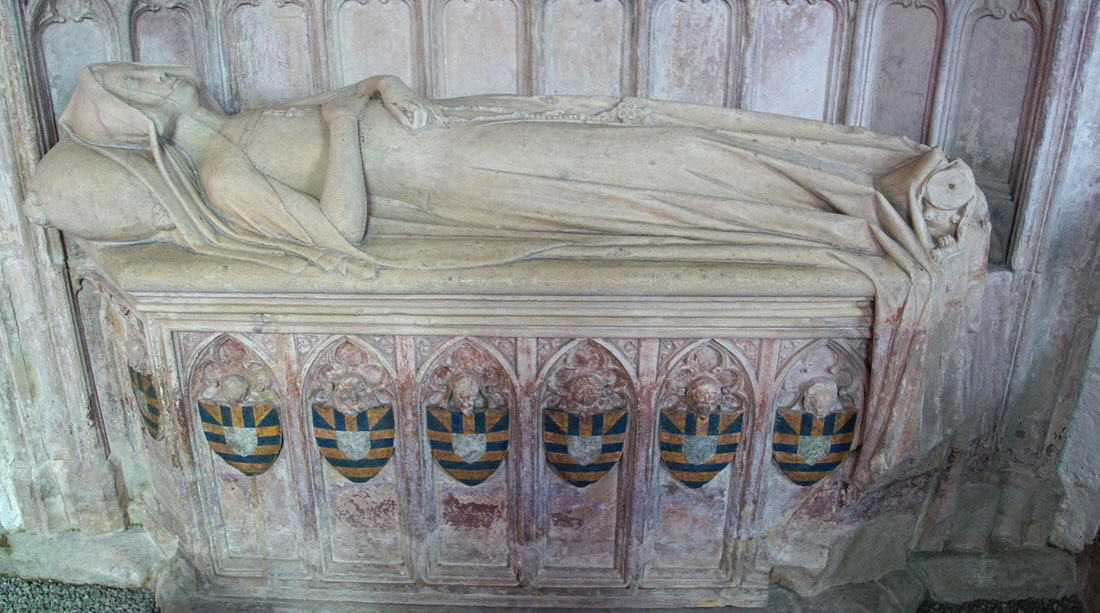 |
|||||||||||||||||||||||||||||||||||||||
|
Blanche Mortimer’s effigy which made such a deep impression on Simon Jenkins! Note the way her long dress drapes over the end of the monument. Her pose is naturalistic - she might be asleep - and her face is serene and beautiful. |
|||||||||||||||||||||||||||||||||||||||
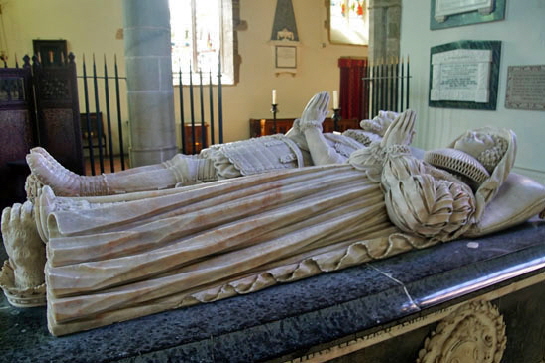 |
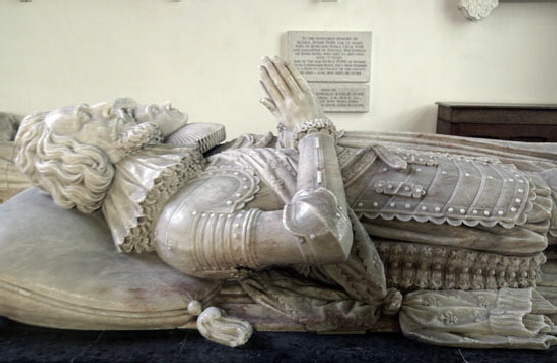 |
||||||||||||||||||||||||||||||||||||||
|
Left and Right: The monument of Sir John Kyrle (1568-1660) and his wife Sybil Scudamore (d.1637). Sir John lived to the, for the time, great age of ninety-two, outliving his wife by twenty-three years. An information board in the church says that the monument was probably carved by Samuel Baldwin of Gloucester who carved several such monuments in the area, including Bredon which will feature late in this Church Trail. |
|||||||||||||||||||||||||||||||||||||||
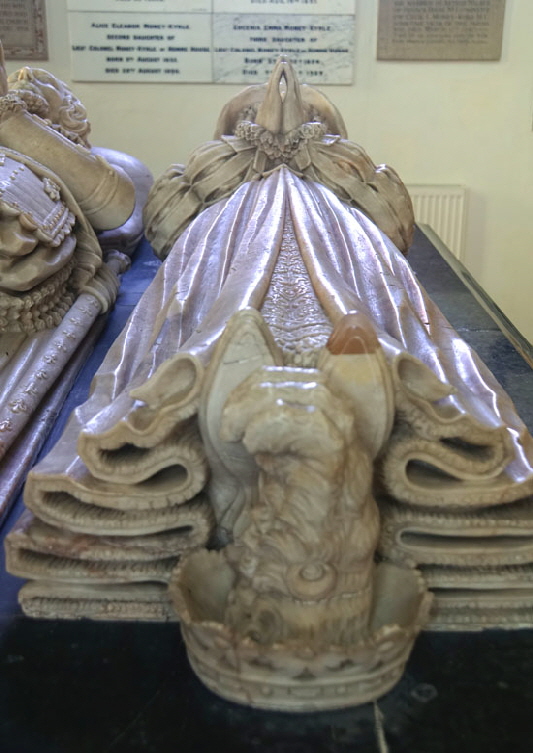 |
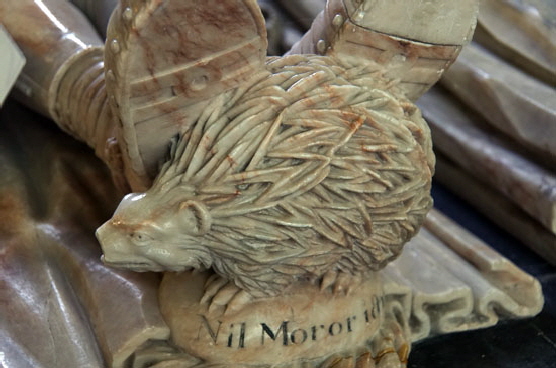 |
||||||||||||||||||||||||||||||||||||||
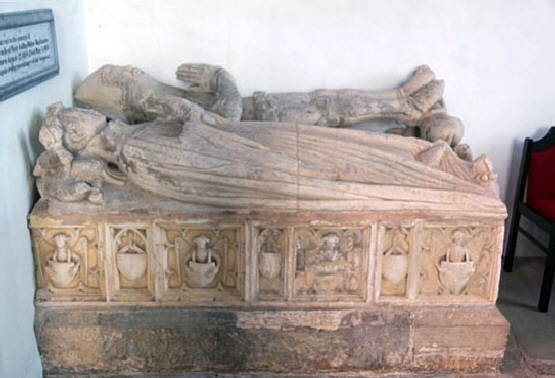 |
|||||||||||||||||||||||||||||||||||||||
|
Left: One of the most interesting things on the Kyrle monument are the family emblems upon which the feet of the deceased rest. Lady Kyrle’s feet rest on the symbol of a bear’s paw emerging from a coronet. Note the voluminous folds of her dress on this no-expenses-spared piece. These monuments must have been fabulously expensive but if one could put a value on a posthumous presence that has lasted for centuries and could still be there for many centuries to come then the patrons would probably think their money well-spent. Right Above: Sir John’s feet rest on his family emblem of a hedgehog. The motto “Nil Moror Isctus” means “Never Delay a Blow” and the church information board says that there is the implied subtext “In the Cause of Right”, How po-faced! I prefer to think the subtext is more in keeping with the Old Hill Street Blues injunction “Let’s do it to them before they do it to us”! This was a man that lived through the Civil War, for heaven’s sake! Right Lower: Also within the so-called Kyrle Chapel is this earlier monument to Thomas Walwyn (d.1415) and Isabella Hathaway. Thomas’s mother, interestingly, was Johanna de Helyon daughter of Walter de Helyon of wooden effigy fame. This indicates the de Helyon line continued to prosper without breaking into the world of title aristocracy. I am again indebted to the information board which informs us that Thomas’s will is one of the first to survive in England. Of even greater interest, from a sociological point of view, is that he enjoined that some land was to be sold. A third of the proceeds should go to funding the building of Much Marcle’s steeple. Another third should go to good works that included “poor prisoners, the neighbourhood poor and the marriage of young women”. The final third was - have you guessed it? - the establishment of a chantry within the church - probably the Kyrle Chapel itself. So two thirds of the money ends up with the church. Thomas’s immortal soul was clearly a big consideration in his will. The charitable donation bespeaks of an act of simple philanthropy. I find the concern for “poor prisoners” particularly interesting as it suggests that the better-off in society did not necessarily slavishly support a “serves then right, hanging’s too good for them!” approach to justice. Also interesting is that Thomas is dressed in soldier’s attire whereas Walter looked every inch the civilian. |
|||||||||||||||||||||||||||||||||||||||
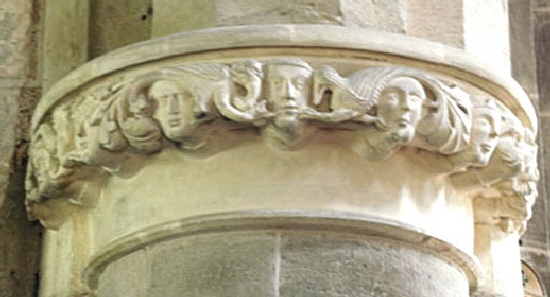 |
|||||||||||||||||||||||||||||||||||||||
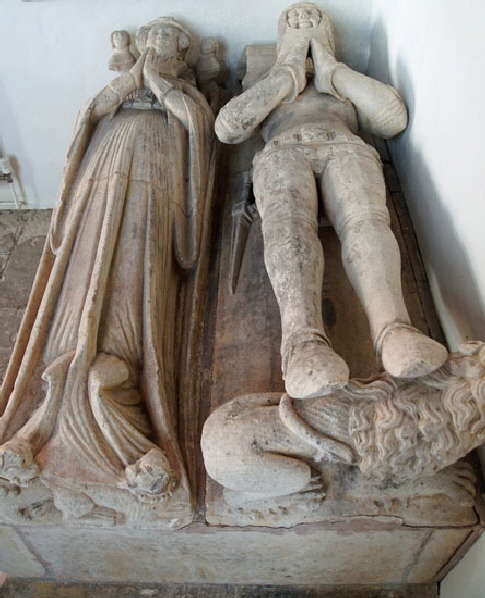 |
|||||||||||||||||||||||||||||||||||||||
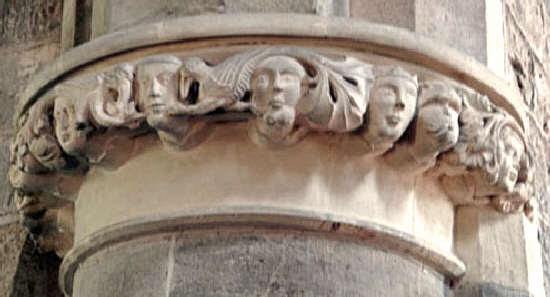 |
|||||||||||||||||||||||||||||||||||||||
|
Left: Another view of the Walwyn monument. They look a cheerful and contented couple, don’t they? Right Above and Below: The westernmost capitals of the arcades are sumptuously carved. The composition on the south side is quite spectacular. The quality of the carving here is quite awesome. Quite what it all means is impossible to determine but the imagination at work here and the skills of the sculptor are of a quality that loses nothing by comparison with the (earlier) Herefordshire School that features so much on this Church Trail. There is a king or a prince with a coronet and one head is beset by pecking birds on each side. The faces themselves are in the main humanistic: there is no grotesquery here. It is all symbolic, of course it is, but the sculptor here had a very clear idea he was trying to represent. I do seriously wonder if there is a better-carved post-Romanesque capital to be seen anywhere in England? It is simply exquisite. |
|||||||||||||||||||||||||||||||||||||||
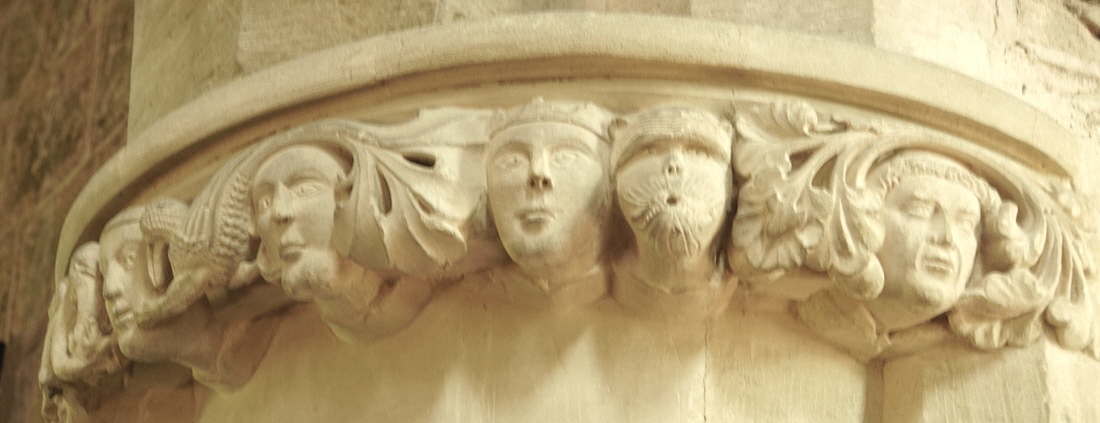 |
|||||||||||||||||||||||||||||||||||||||
|
The king or prince is in the centre of this image. To his left (our right) is peculiar half-man, half-animal face with heavy brow, pursed lips and a peculiar beard. The we have two faces that approximate to green men, surrounded as they are by leaves - but these leaves are the tails of elaborately-carved birds with long beaks. The likelihood is that these birds are meant to be peacocks. The Greeks believed that peacock flesh did not rot and this notion was adopted by Christianity to signify immortal life. |
|||||||||||||||||||||||||||||||||||||||
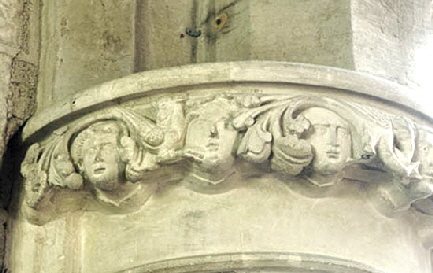 |
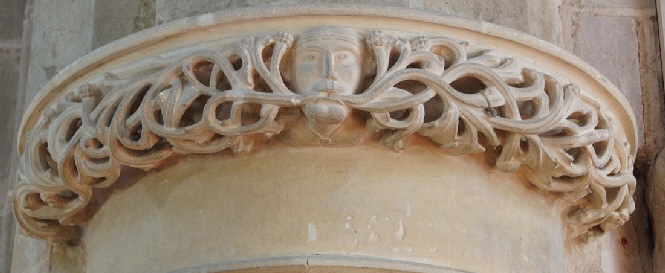 |
||||||||||||||||||||||||||||||||||||||
|
Left: A further image of the south east capital. Right: The north east capital, on the other hand, is occupied by a single very elaborate green man. It is clearly by the same sculptor. There are as many theories about green men as there are days in the year and it is very fashionable to debunk the once fashionable notion that it is a fertility symbol. They are certainly ubiquitous on this Church Trail. Rita Wood in her book “Paradise” (and doubtless others) proposes that the leaves are to be equated with “breath made Visible”, a symbol of resurrected life. She contends that leaves emanating from grotesques, on the other hand - as opposed to from men and animals - represents breath being expelled in the throes of death by the wicked and sinful. It is a beguiling theory because it answers the question as to why so many “green men” are not men at all. It also rationalises the placement of this imagery at Much Marcle directly in front of the chancel. The distinction between Christianity and paganism was not as clear to mediaeval people as it seems to be to modern people but nevertheless one might not have expected to see quite so many pagan images within a church as there sometimes was. With the peacocks showing resurrection on one side of the nave and the green man suggesting the same, Rita Wood’s contention seems to hold water at Much Marcle. |
|||||||||||||||||||||||||||||||||||||||
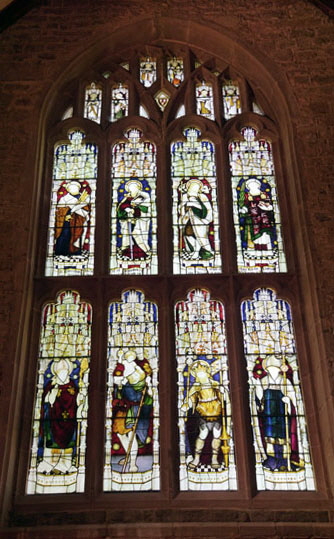 |
|||||||||||||||||||||||||||||||||||||||
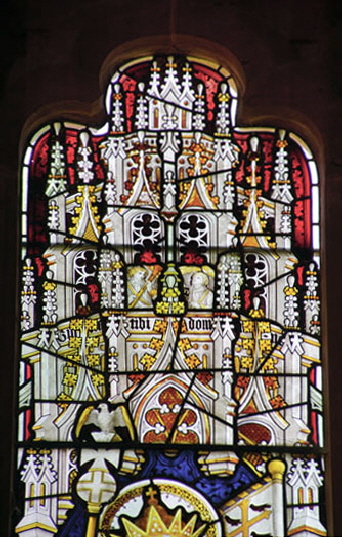 |
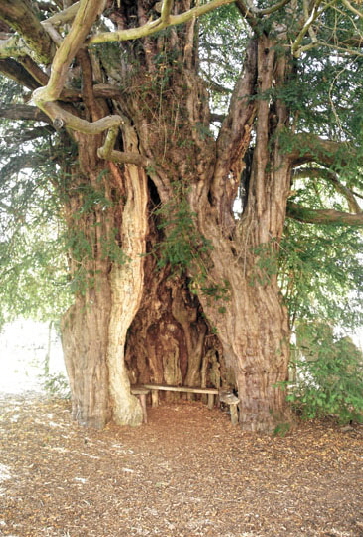 |
||||||||||||||||||||||||||||||||||||||
|
Left: There is a lot of good glass by the renowned Kempe. The west window is of 1882 and shows eight saints. Centre: Close up of some of the west window glass. Kempe has reproduced the mediaeval conceit of showing the architecture of the time in glass. For an example of the “real thing” take a look at Dennington in Suffolk. Right: There is a wonderful ancient yew in the churchyard and benches have been placed inside it. |
|||||||||||||||||||||||||||||||||||||||
|
Click Here to Return to “The World’s Greatest Church Trail II” |
|||||||||||||||||||||||||||||||||||||||
|
|
|||||||||||||||||||||||||||||||||||||||